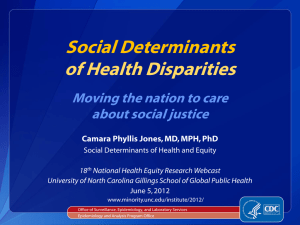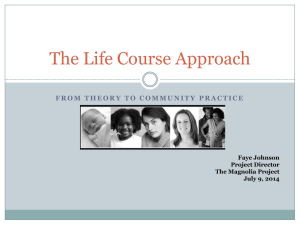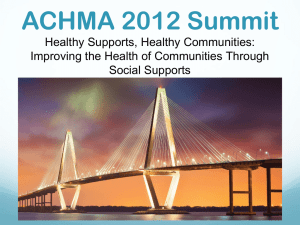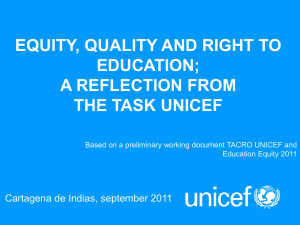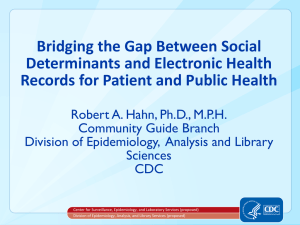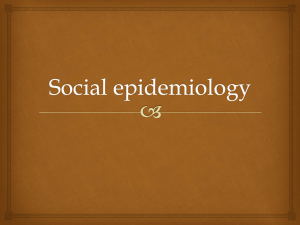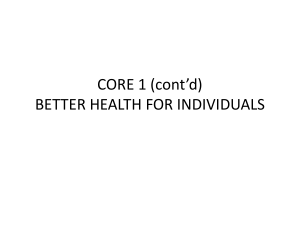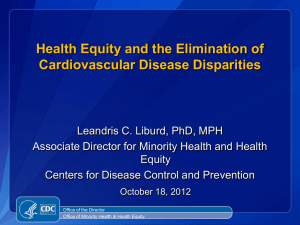Social Determinants of Health Disparities
advertisement
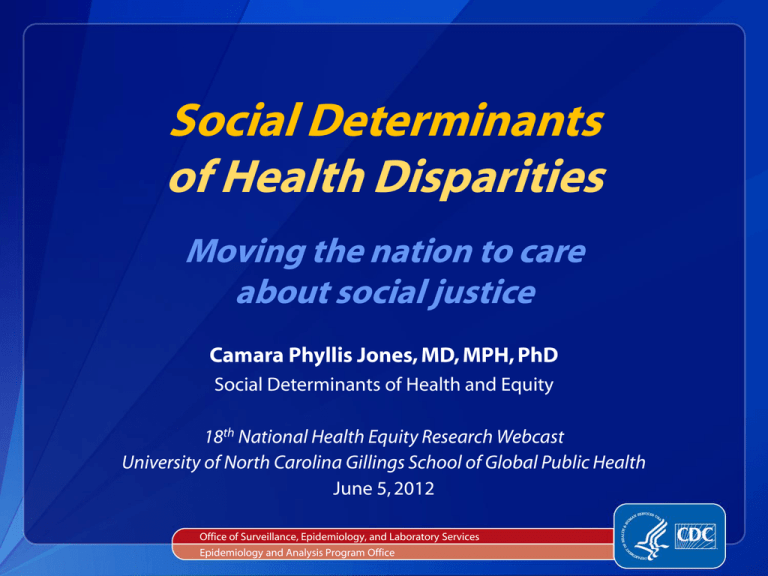
Social Determinants of Health Disparities Moving the nation to care about social justice Camara Phyllis Jones, MD, MPH, PhD Social Determinants of Health and Equity 18th National Health Equity Research Webcast University of North Carolina Gillings School of Global Public Health June 5, 2012 Office of Surveillance, Epidemiology, and Laboratory Services Epidemiology and Analysis Program Office Social Determinants of Health Disparities Moving the nation to care about social justice The findings and conclusions in this presentation are those of the author, and do not necessarily represent the official position of the U.S. Centers for Disease Control and Prevention. Office of Surveillance, Epidemiology, and Laboratory Services Epidemiology and Analysis Program Office Overview Social determinants of health disparities differ from social determinants of health Health disparities don’t “just to happen” Definition of racism Generalized definition of structured inequity Three-part definition of health equity International Convention on the Elimination of all forms of Racial Discrimination Barriers in moving the nation to care about social justice Ahistorical culture Myth of meritocracy Focus on the individual Levels of health intervention Addressing the social determinants of health Primary prevention Safety net programs and secondary prevention Medical care and tertiary prevention But how do disparities arise? Differences in the quality of care received within the health care system Differences in access to health care, including preventive and curative services Differences in life opportunities, exposures, and stresses that result in differences in underlying health status Differences in quality of care (ambulance slow or goes the wrong way) Differences in access to care Differences in exposures and opportunities Addressing the social determinants of health disparities: Why are there differences in resources along the cliff face? Why are there differences in who is found at different parts of the cliff? 3 dimensions of health intervention 3 dimensions of health intervention Health services 3 dimensions of health intervention Health services Addressing social determinants of health 3 dimensions of health intervention Health services Addressing social determinants of health Addressing social determinants of health disparities Source: Jones CP et al. J Health Care Poor Underserved 2009. What is racism? A system What is racism? A system of structuring opportunity and assigning value What is racism? A system of structuring opportunity and assigning value based on the social interpretation of how we look (“race”) What is racism? A system of structuring opportunity and assigning value based on the social interpretation of how we look (“race”) Unfairly disadvantages some individuals and communities What is racism? A system of structuring opportunity and assigning value based on the social interpretation of how we look (“race”) Unfairly disadvantages some individuals and communities Unfairly advantages other individuals and communities What is racism? A system of structuring opportunity and assigning value based on the social interpretation of how we look (“race”) Unfairly disadvantages some individuals and communities Unfairly advantages other individuals and communities Saps the strength of the whole society through the waste of human resources Source: Jones CP. Confronting Institutionalized Racism. Phylon 2003;50(1-2):7-22. What is [inequity] ? A system of structuring opportunity and assigning value based on [fill in the blank] What is [inequity] ? A system of structuring opportunity and assigning value based on [fill in the blank], which Unfairly disadvantages some individuals and communities Unfairly advantages other individuals and communities Saps the strength of the whole society through the waste of human resources Many axes of inequity “Race” Gender Ethnicity Labor roles and social class markers Nationality, language, and legal status Sexual orientation Disability status Geography Religion These are risk markers, not risk factors Achieving health equity “Health equity” is assurance of the conditions for optimal health for all people Achieving health equity requires Valuing all individuals and populations equally Recognizing and rectifying historical injustices Providing resources according to need Health disparities will be eliminated when health equity is achieved Source: Jones CP 2010, adapted from the National Partnership for Action to End Health Disparities. ICERD: International Convention on the Elimination of all forms of Racial Discrimination International anti-racism treaty adopted by the UN General Assembly in 1965 http://www2.ohchr.org/english/law/cerd.htm US signed in 1966 US ratified in 1994 2nd US report submitted to the UN Committee on the Elimination of Racial Discrimination (CERD) in 2007 http://www2.ohchr.org/english/bodies/cerd/docs/AdvanceVersion /cerd_c_usa6.doc CERD Concluding Observations 14-page document (8 May 2008) available online http://www.state.gov/documents/organization/107361.pdf Concerns and recommendations Racial profiling (para 14) Residential segregation (para 16) Disproportionate incarceration (para 20) Differential access to health care (para 32) Achievement gap in education (para 34) Changing opportunity structures Challenges and strategies Understand the importance of history Challenge the narrow focus on the individual View systems and structures as modifiable Transform consumers to citizens Expose the myth of meritocracy Break down barriers to opportunity Build bridges to opportunity Valuing all people equally Challenges and strategies Break out of bubbles to experience our common humanity Embrace all children as OUR children Open up decision-making processes to achieve transparency, inclusion, and parity Reprise Social determinants of health disparities differ from social determinants of health Health disparities don’t “just to happen” Definition of racism Generalized definition of structured inequity Three-part definition of health equity International Convention on the Elimination of all forms of Racial Discrimination Barriers in moving the nation to care about social justice Ahistorical culture Myth of meritocracy Focus on the individual Camara Phyllis Jones, MD, MPH, PhD 1600 Clifton Road NE Mailstop E-33 Atlanta, Georgia 30333 (404) 498-1128 phone (404) 498-1111 fax cdj9@cdc.gov For more information please contact Centers for Disease Control and Prevention 1600 Clifton Road NE, Atlanta, GA 30333 Telephone, 1-800-CDC-INFO (232-4636)/TTY: 1-888-232-6348 E-mail: cdcinfo@cdc.gov Web: www.cdc.gov The findings and conclusions in this report are those of the authors and do not necessarily represent the official position of the Centers for Disease Control and Prevention. Office of Surveillance, Epidemiology, and Laboratory Services Epidemiology and Analysis Program Office
